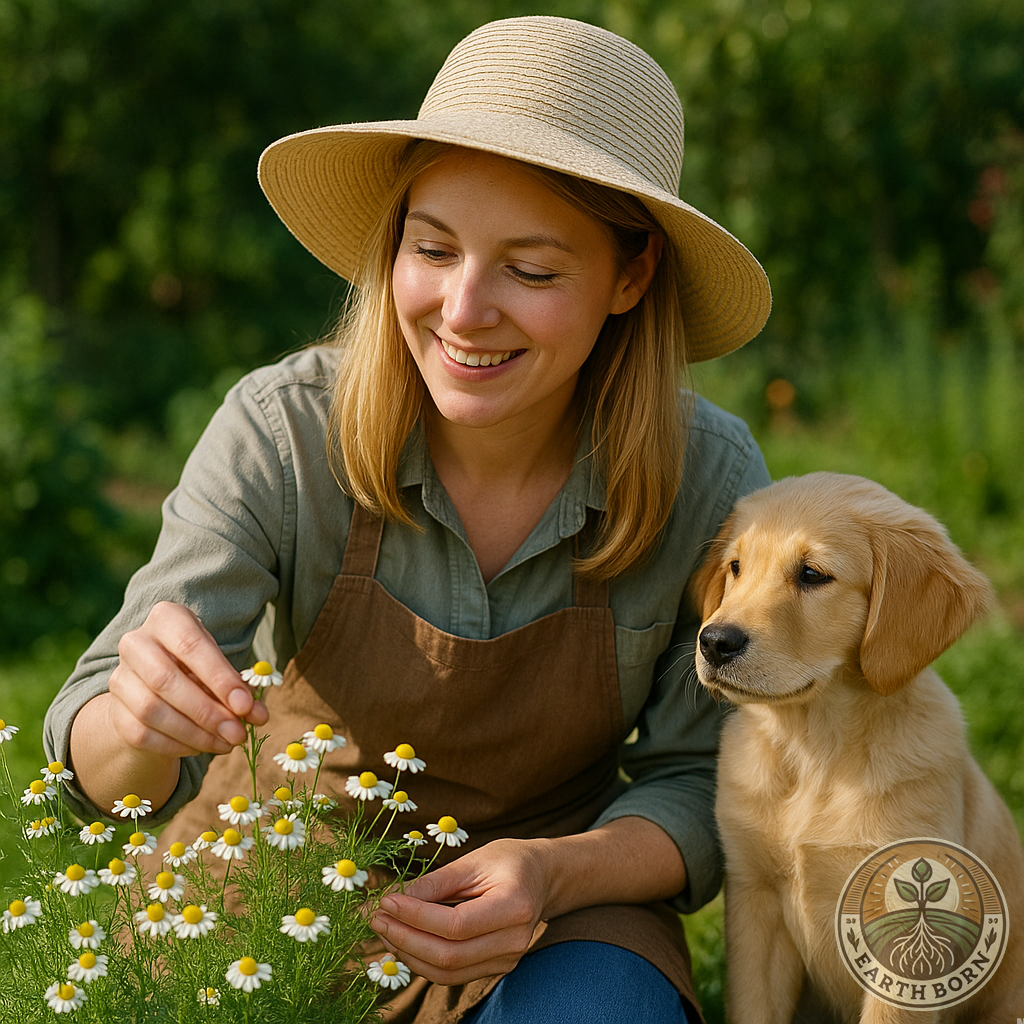
German Chamomile (Matricaria chamomilla), also called Wild Chamomile or Scented Mayweed, is a delicate annual herb from the Asteraceae family. With its daisy-like white petals and golden-yellow centers, it has been cultivated for centuries across Europe and Asia. Known for its sweet apple-like scent, chamomile was revered in ancient Egyptian, Greek, and Roman traditions as a calming and healing herb. Today, it remains one of the most popular medicinal plants worldwide.
💊 Medicinal Benefits
German Chamomile contains active compounds such as chamazulene and apigenin, giving it powerful medicinal uses:
- 🌿 Anti-inflammatory – eases skin irritations, wounds, and joint pain.
- 🌿 Digestive aid – relieves bloating, indigestion, and nausea.
- 🌿 Relaxant – reduces stress, anxiety, and improves sleep.
- 🌿 Antimicrobial – fights bacteria and supports wound healing.
It is most commonly used in herbal teas, essential oils, and topical salves. See this post for a few recipes
📅 When to Plant in South Africa
Sow German Chamomile in spring (September–October) or early autumn (March–April). Spring sowing ensures flowers by early summer, while autumn sowing allows plants to establish before cooler months.
🏡 Where to Plant
Chamomile thrives outdoors in garden beds or borders but also does well in pots. Choose a sunny, sheltered spot where its fragrance can be enjoyed.
🌞 Soil, Water & Sunlight Requirements
✅ Soil – Well-draining, sandy to loamy soil with moderate fertility.
✅ Sunlight – Full sun (6–8 hrs daily), though it tolerates light shade.
✅ Water – Keep soil moist but not waterlogged; allow surface to dry between waterings.
✅ Fertilize – Minimal feeding required; a monthly light application of compost tea is enough.
✅ Spacing – 15–30 cm between plants.
✅ Seeds germinate – 7–14 days in warm soil.
✅ Transplanting – Move seedlings once 2–3 weeks old or when they have 2–3 true leaves.
✅ Maturity height – 30–60 cm tall.
🍓 Flowers & Fruit
The plant produces small, daisy-like white flowers with yellow centers, highly aromatic and prized for tea. Flowers appear about 60–90 days after sowing.
🌼 Companion Plants
Chamomile improves the growth and flavor of basil, mint, cabbage, onions, and cucumbers. It also attracts pollinators and beneficial insects like ladybugs that feed on aphids.
🐛 Common Pests
- Aphids
- Spider mites
- Powdery mildew in humid conditions
Regular inspection and companion planting help prevent infestations.
🧺 Harvesting
Harvest flowers just after they open, usually in early to mid-summer. Cut flower heads in the morning after dew has dried. Regular picking encourages more blooms.
🫙 Storage
Air-dry flowers in a warm, well-ventilated room. Store in airtight glass jars away from light and moisture. Dried chamomile retains potency for up to 12 months.
🧪 How to Use as Medicine
- Tea infusion: 1–2 tsp dried flowers per cup of hot water, steep 5–10 min. Calms digestion and promotes sleep.
- Steam inhalation: Add dried flowers to hot water to relieve colds and sinus congestion.
- Topical compress: Apply cooled tea to soothe irritated skin or inflamed eyes.
- Essential oil: Used in massage blends for relaxation and skin healing.
🎉 Fun Fact
The name “chamomile” comes from the Greek khamai (ground) and melon (apple) – meaning “ground apple” – because of its sweet, apple-like scent.
⚠️ Caution
- May trigger allergic reactions in people sensitive to ragweed, daisies, or marigolds.
- Can interact with blood-thinning medication (e.g., warfarin).
- Avoid large doses during pregnancy without medical supervision.
📣 Call to Action
German Chamomile is a gentle healer and a joy to grow – offering beauty, fragrance, and wellness benefits right from your garden. 🌼 Start your own chamomile patch this season and enjoy homegrown herbal tea and remedies.
👉 Share your chamomile garden with us at #EarthBornGrower and inspire others to grow their own medicine!


 **Meet Sprout!** Sprout is your friendly gardening companion at Earthborn, always ready with helpful advice on plant care, medicinal herbs, and natural gardening solutions. From seedling to harvest, Sprout provides expert guidance to nurture your garden and your well-being—making gardening easy, fun, and naturally rewarding.
**Meet Sprout!** Sprout is your friendly gardening companion at Earthborn, always ready with helpful advice on plant care, medicinal herbs, and natural gardening solutions. From seedling to harvest, Sprout provides expert guidance to nurture your garden and your well-being—making gardening easy, fun, and naturally rewarding.

[…] Chamomile (Matricaria chamomilla) is one of the gentlest yet most powerful healing herbs, treasured for its […]